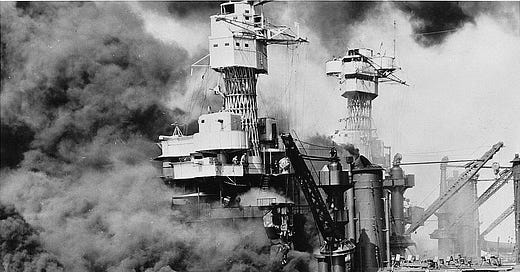TDIH: Pearl Harbor
Our Pacific Fleet took a serious blow—albeit not the mortal one that the Japanese hoped to inflict.
On this day in 1941, the Japanese attack Pearl Harbor. The results for the United States Navy were disastrous. Our Pacific Fleet took a serious blow—albeit not the mortal one that the Japanese hoped to inflict.
“They caught us flat-footed,” one Navy admiral would later confess.
The Japanese had been pretty worried. Would the United States try to stop their imperialistic efforts in Southeast Asia? The Japanese had no illusions about our industrial capacity: It was massive and could outstrip Japanese efforts. Better to nip such a possibility in the bud by preemptively destroying the U.S. Pacific Fleet.
The move was risky. A large Japanese fleet would need to travel thousands of miles across the Pacific, in complete secrecy and radio silence. It would need to refuel along the way. And it might travel the whole distance to Hawaii, only to discover the American fleet gone.
The Japanese succeeded, at least in part, because Americans made a few mistakes along the way.
Clues were missed. Or, when found, they were not communicated properly to the people who needed to know. Sometimes the Army thought the Navy was taking care of something, even as the Navy made the opposite assumption. What could have happened if the armed forces had worked together, compiling these clues into a complete picture?
And there were many clues!
Code names for Japanese vessels were being changed too often. Traffic patterns among Japanese ships didn’t always make sense. In the days before the attack, the location of several Japanese aircraft carriers was unknown. Japanese communications indicated that something big was coming.
Indeed, in late November, two separate warnings were communicated to the military. These warnings didn’t come from just anyone. They were approved by the highest-ranking officers in both the Army and Navy. But, as one historian notes, the warnings were so “indirectly and clumsily phrased that they had failed to warn.” Instead, recipients continued to assume that the real danger was in Southeast Asia.
Clues were even missed on the day of the attack.
At about 7:00 a.m. that morning, Private George E. Elliott, Jr. and another soldier were monitoring a mobile radar unit in Oahu. “Suddenly,” he later said, “there appeared the largest blip either of us had ever seen on an oscilloscope.” Little did they know it, but they’d found the Japanese airplanes, still en route to their target. The two soldiers called in a report, but their concerns were dismissed. The officer in charge thought the blips came from a flight of B-17s flying in from San Francisco.
At almost the same exact time, a Navy destroyer was patrolling the waters just outside Pearl Harbor. It ran into a Japanese submarine. Acting quickly, its commander fired upon the submarine, then called in a report. That report ran into bureaucratic delays and didn’t make it to anyone in time to prevent what was coming.
“What was coming” turned out to be massive. The Japanese launched 353 airplanes from six aircraft carriers. More than 2,400 Americans were killed. Eight battleships in “Battleship Row” were damaged or destroyed. Memorably, USS Arizona exploded and sank; more than 1,100 of her crew members were lost.
Naturally, the Greatest Generation didn’t take the attack at Pearl Harbor lying down. Just six months later, the United States Navy would come back to win a decisive victory at the Battle of Midway.
That battle would be the beginning of the end for the Imperial Japanese Navy.
Sources can always be found on my website, here.





A day that will live in infamy. It was a horrible day for Americans, but they/we are as a whole a resilient people. They rose up stronger and came back to grab victory. The saddest part is that they couldn’t bring back all the ones that lost their lives that day. So glad you choose to remember this day every year. Tara. When we forget the event we forget the lessons and the mistakes get repeated with disastrous results.
My father joined the Navy right after the Pearl Harbor attack, as did so many other Patriotic young men and women. The war footing was coming with the efforts of an entire nation and when we were forced to join the war, we did so in a way never seen before or after.
My father served for the duration which in his case was over 3 1/2 years. He sailed into both theaters of war and he sailed on his LST'S the equivalent of 3 and a half times around the world.
My father left the Navy for a civilian life as a Chief Petty Officer. He would have been 103 years old day before yesterday. May, my father and all of the Greatest Generation who have passed, rest in peace. God bless the Greatest Nation in the history of the world. Thank you Tara.